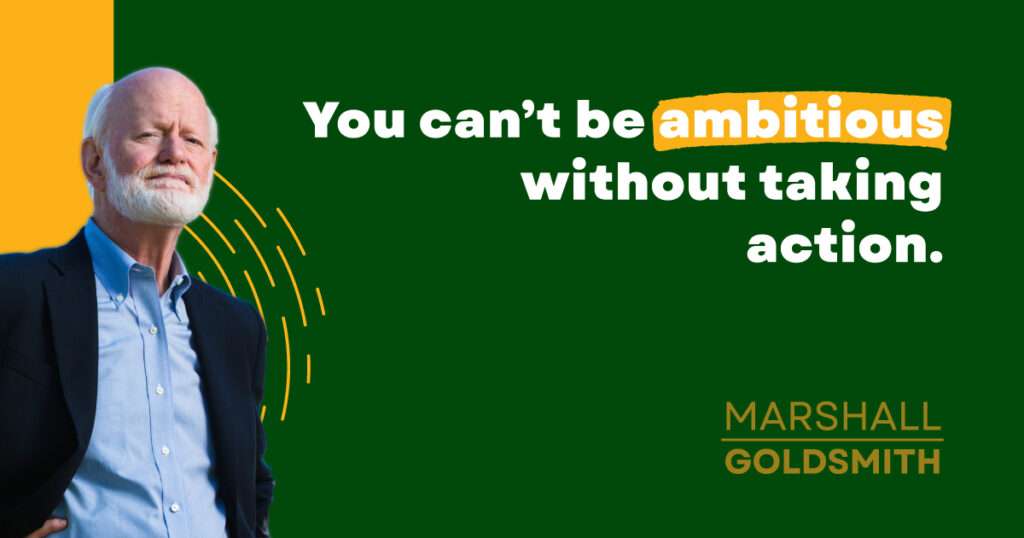Playing Favorites By Marshall Goldsmith There’s a reason I devote...
You can’t be ambitious without taking action. And you can’t really live a fulfilled life without aspiring to be someone, to grow constantly. You want to appreciate your life, to earn your life, and not have to ask yourself, ‘Is that all there is?’
When I explain the model of Action, Ambition, and Aspiration to clients and other coaches, they get it. Their initial takeaway is that the Triple A’s (as I call them) are three independent variables, and they are not necessarily connected. We have to connect them to enable them in our lives.
Clients and coaches understand that for many people Action is random and unfocused, and that it serves no other purpose than satisfying an impulse or an immediate need. People cook dinner because they’re hungry. People go to work because they need a paycheck. People watch their favorite teams play at the neighborhood bar because that’s what their friends are doing. These are justifiable actions, not necessarily grim and joyless. But what goal achievement or even higher purpose are they connected to?
I created a chart that I give to clients and coaches that can help them see more clearly.
Here it is:
Activity Action Ambition Aspiration
Time horizon Immediate Time-bound Infinite
Profile What you do What you want to What you want to become
achieve
Definition (write as much as you like)
I go around the room asking them to fill in the blanks. I’m curious to see how many of them have successfully integrated a specific Action to a defined Ambition and to their Aspiration. The successful executives and leaders have an easy time defining Action and Ambition, but often draw a complete blank on Aspiration, as if they’ve never considered it. I’m not surprised.
The vast majority of the successful business people I know live a life dominated by Ambition. Because they are highly motivated to achieve specific goals, they have the discipline to subordinate their Action to their Ambition.

The two are in sync. I don’t know many executives who would not include being recognized as a superior leader near the top of their Ambition list. One of the things I teach them to do is suppress some of their harsher judgments and comments in the workplace—because superior leaders don’t create a toxic environment. They strive to be universally kind and generous, even among disappointing colleagues who may deserve tougher love. If they have lapses, forgetting that their daily interpersonal behavior is supposed to be serving a major career goal, that’s when I’m called back in—to remind them of their Aspiration and help them realign their Action with it.
If they’re not careful, however, (especially in a competitive business environment where hitting targets is how we keep score) their discipline can easily turn into goal-obsession. Like politicians who campaign on Aspiration (their higher ideals) but, because politics is messy and compromising, govern on Ambition (their need to win the next election), the executives are at risk of forgetting their values and their original reason for planting the goal—namely, to serve their Aspiration.
It’s all-too-common that executives who become obsessed with their goal neglect the people they claim they’re working for, namely, the people they love. They become lost in their Ambition, regardless of whether they’ve defined their Aspiration or articulated their higher values. They might as well be hitting targets in target practice.
Many coaches who respond to the chart tend to be well-meaning and idealistic. They fill in the blanks differently. They’re quite clear on Aspiration, for example, being present, serving others, making the world a better place. But they’re fuzzy about the actions and goals they’re pursuing to serve their Aspiration.
They’re reluctant to do the hard, uncomfortable things required in this online era—mostly the performative “hand shaking” with the marketplace via social media, writing, and public speaking—to expand their reach and help more people. True, they’re making a living and doing good, but they’re falling short on Aspiration because they haven’t adequately linked it to Action and Ambition. In many cases, they never determined what their Action and Ambition should be.
I myself have an Aspiration to create the maximum benefit for as many people as I can in the time I have left to do it. To fulfill that, I will be publishing a book shortly called The Earned Life. So, what I’m doing is consistent with my goal for this coming year, which serves my more-distant dream of helping as many people as possible.
Previously, I wrote about my Every Breath Paradigm, which is a way of understanding yourself and your place in the continuum of your time on Earth, inspired by Buddha. The Every Breath Paradigm proposes that your own self is a countless series of selves made up of the old self, the current self, and the future self — changing from one to the next with every breath you take.
In this regard, Aspiration is also the mechanism that best supports and clarifies this Every Breath Paradigm, since Aspiration is all about continuing growth and change. (By the way, the word “aspiration” stems from the Latin aspirare, meaning “to breathe” — so how neat is that?)
When he was twenty-one, Curtis Martin — who went on to play for the New England Patriots and the New York Jets — decided, after hesitating to commit, to play in the NFL as an investment in his future self. He didn’t play for the love of the game. He didn’t know whether he’d succeed in the NFL, where the average length of a running back’s career is three years. He risked concussions, brain damage, permanent physical debility—which is like going off to war, although no one thanks you for your service.
But for him it was an acceptable risk. In aspiring to a post-NFL self, he was creating separation from all his previous selves and, through the acquisition of new values and self-knowledge during his eleven-year Hall of Fame career, becoming a totally unexpected person.
At its core, Aspiration is an act of privileging your future over your present. Think of it as a transfer of power from old to new.
No matter how risk-averse you think you are, when you Aspire, you are choosing to be a little bit of a gambler. Using the currency of your time and energy, you are betting that the future-you will be an improvement over the current-you.
Don’t be surprised how tenaciously and creatively you try to win that wager.
It is how a life is earned.

Adding Too Much Value Won’t Get You There By Marshall...
C-Suite Master Class: No, But, However By Marshall Goldsmith Continuing...
The Doerr Institute: Expanding the Market for Coaches By Marshall...
Making Leadership Development Part of the College Degree at Rice...
Sanyin Siang – Winner of the Thinkers50 Marshall Goldsmith Coaching...
Thinkers50 Marshall Goldsmith Distinguished Achievement Award in Coaching – Nominees...
Leading with Influence: What Is Influence360°? By Marshall Goldsmith Founder...
Are You a Dominator, Manipulator, Persuader or Influencer? By Marshall...
Leading with Influence: Redefining Modern Influence Part 2 By Marshall...
My mission is simple. I want to help successful people achieve positive, lasting change and behavior; for themselves, their people, and their teams. I want to help you make your life a little better. With four decades of experience helping top CEOs and executives overcome limiting beliefs and behaviors to achieve greater success, I don’t do this for fame and accolades. I do this because I love helping people!
As an executive educator and coach, I help people understand how our beliefs and the environments we operate in can trigger negative behaviors. Through simple and practical advice, I help people achieve and sustain positive behavioral change.